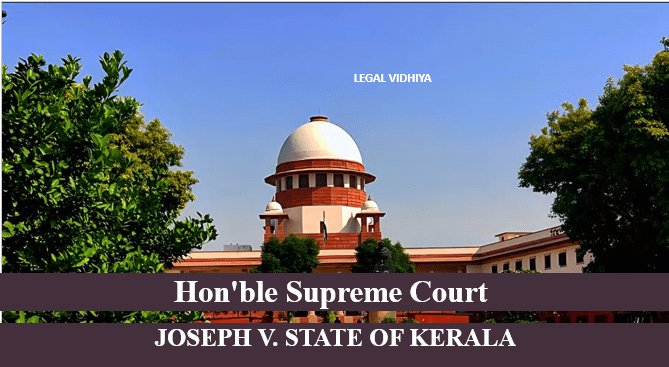
| CITATION | 620 OF 1995 |
| DATE OF JUDGMENT | DEC 3,2002 |
| COURT | SUPREME COURT OF INDIA |
| APPELLENT | JOSEPH |
| RESPONDENTS | STATE OF KERALA |
| BENCH | J. RAJENDRA BABU,JJ. ARUN KUMAR |
FACTS:
The appellant and two companions were charged with offenses under Sections 341,( Whoever wrongfully restrains any person shall be punished with simple imprisonment for a term which may extend to one month, or with fine which may extend to five hundred rupees, or with both. )’ 307,(Imprisonment for up to Ten Years: If a person commits an act with the intent to murder but does not cause any harm, they may be imprisoned for a term that may extend to ten years. A fine may also be imposed.) and 302 (“Whoever commits murder shall be punished with death or imprisonment for life and shall also be liable to fine)along with Section 34(When a criminal act is done by several persons in furtherance of the common intention of all, each of such persons is liable for that act in the same manner as if it were done by him alone”)) of the Indian Penal Code. It was alleged that on 9-7-1989, near the bunk shop owned by Kolasseri Pappachan at Konipadu junction, they forcibly restrained movement on the road, resulting in the murder of Simon and causing injuries to Benny (PW 1), after which they fled the scene.
Upon trial, the court concluded that the charges against the appellant and the other accused were not proven and subsequently acquitted them. The State subsequently appealed to the High Court.
A Division Bench of the High Court overturned the acquittal order, finding the appellant guilty, but left the trial court’s acquittal of the other two accused undisturbed. Unfortunately, Simon succumbed to his injuries at 7.45 p.m. while en route to the hospital.
ISSUES:
Is there enough substance in Benny’s (PW 1) testimony to prove the appellant’s guilt beyond a reasonable doubt?
Was the trial court’s decision to acquit the accused supported by the presented evidence?
JUDGMENT OF THE CASE:
In a case of this kind, when there exists a sole witness to the incident, his testimony must be approached with caution and evaluated in light of the evidence presented by other witnesses or recorded evidence. The contention before the Court is that the FIR Exhibit P-1 displayed a signature of questionable authenticity, a fact acknowledged by PW I himself, who admitted it differed from the one he provided when acknowledging the receipt of the summons. The reliability of his testimony came into question when PW I asserted that he hurried to the junction to inform PWs 2 to 4, and then promptly returned to the scene of the incident. Meanwhile, the deceased also fled to the western side of the incident site, despite bleeding profusely, and he grasped his wound with his hand while running. If this were indeed the case, there would have been blood scattered throughout the area, rather than concentrated at one specific spot. The abrasion on PW I’s neck could have been caused by a nail scratch rather than a weapon, and it was not a bleeding wound, which contradicts his claim of profuse bleeding. If the witness (PW I) truly had been wearing bloodstained clothing, the police would have certainly seized it for proper examination. Particularly, considering the trial court provided sound rationale for acquitting the accused, the High Court should not have intervened based solely on the possibility of an alternative viewpoint, and not because the trial court’s determination was untenable.
The trial court had reservations about relying on PW 1’s subsequent statement, deeming his evidence highly suspicious. Additionally, the medical evidence failed to support the prosecution’s case, and no clear motive was established. Consequently, the trial court acquitted the accused.
However, the High Court took a different stance, asserting that PW 1’s testimony aligned with his initial statement. Furthermore, the presence of a solitary eyewitness is permissible under Section 134 of the Indian Evidence Act. The High Court ultimately determined that the trial court’s assessment of the evidence was unreasonable, leading to the appellant’s conviction.The appeal is allowed. The order of conviction passed by the High Court is set aside, and the order of acquittal passed by the trial court is restored.Given this perspective, we grant this appeal, overturn the conviction order issued by the High Court, and reinstate the acquittal order issued by the knowledgeable Sessions Judge. The appeal is granted accordingly.
CONCLUSION:
In our view, it seems that the High Court deviated from the mentioned standard and instead analyzed the evidence as if it were being presented for the first time, rather than on appeal. Section 134 of the Indian Evidence Act stipulates that a specific number of witnesses is not mandatory for establishing a fact. Therefore, a court is allowed to base and uphold a conviction on the testimony of a single eyewitness. However, this approach can only be taken if the evidence presented by the witness is compelling, trustworthy, and aligns with logical possibilities, instilling absolute confidence. According to this criterion, when the prosecution’s case primarily hinges on the testimony of a lone eyewitness, it must be entirely reliable. Even if this witness is an injured party and their presence may not be seriously questioned, if their account contradicts other evidence, the trial court’s decision that it would be unsafe to convict the accused solely based on their testimony cannot be considered unreasonable.
REFERENCE:




0 Comments